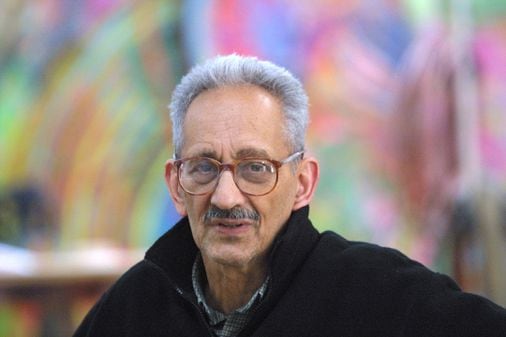Beginning with a rigid, minimal take on abstraction while still a student at Princeton University in the 1950s, Mr. Stella had an unquenchable curiosity that would take him from the canvas to broader, more extravagant hybrid works, and eventually monumental public sculptures that occupy prominent places in cities all over the world.
Matthew Teitelbaum, director of the Museum of Fine Arts Boston, said Mr. Stella “both simplified and reduced the vocabulary of abstraction, challenging assumptions and opening opportunities to look and think differently. His relentless questioning of traditional boundaries in art applies to nearly every formal category of painting and sculpture. It is magical and inspiring.”
Mr. Stella gained fame in his early 20s fresh out of Princeton. In 1959 and 1960, he showed at the landmark exhibition “Sixteen Americans” at New York’s Museum of Modern Art. It would be a first achievement in a storied career with a string of top-flight accolades, culminating in a career-spanning retrospective that heralded the opening of the Whitney Museum of American Art’s soaring new home in Lower Manhattan in 2015.
The exhibition, an exhilarating jaunt through Mr. Stella’s lifetime of wide-ranging formal experimentation, strained to contain his many enthusiasms. As New York Times critic Roberta Smith wrote at the time: “Mr. Stella began by painting himself into a corner — defining his medium so literally that there seemed nothing left to do with it — and has spent most of his career blasting his way out.”

Smith was referring to Mr. Stella’s totemic “Black Paintings,” his entrée to the New York art world. Four of those works, square canvases with dull black house paint pinstriped with parallel strips of raw canvas, were chosen for the “Sixteen Americans” exhibition.
MoMA bought one of them on the spot. Titled “The Marriage of Reason and Squalor, II,” 1959, it became an icon of the exhibition’s central question: After more than a decade of Abstract Expressionism — the rough, gestural art movement born in New York in the 1940s and championed by MoMA itself — where would painting go from here? With his sparse, elegant compositions, Mr. Stella helped chart the path: The Black Paintings would become part of the foundation for such movements as Minimalism and Post-Painterly Abstraction, which would spiral into divergent responses to Abstract Expressionism’s dominance. To the AbEx generation’s angst-ridden claims of painting pure emotion, Mr. Stella had replied with the dry wit that would permeate the whole of his career: “Painting is a flat surface with paint on it,” he once said. “What you see is what you see.”

Mr. Stella, the oldest of three children, grew up in Malden. His father was a doctor, and his mother, a landscape painter. He was searching for new ways of expressing his creative fire as early as high school at Phillips Academy in Andover. In the early 1950s, when he was a student there, major museums near his hometown, including the Museum of Fine Arts, Boston, were filled with historical masterpieces and emblematic works of early European Modernism by artists such as Vincent Van Gogh and Claude Monet. Those same institutions had shown limited interest in displaying what was happening in the blossoming epicenter of international art in New York.
As a student at Phillips, however, Frank Stella found himself with a close-up view of a burgeoning American avant-garde. There, he studied painting with Patrick Morgan, who had taken a keen interest in the American abstract movement. The school’s Addison Gallery of American Art had been an early adopter of Abstract Expressionism; by the time he was a student there, its holdings in the field were deep and impressive. “We saw Jackson Pollock there, Franz Kline — everything that was going on in New York. It was very advanced,” Mr. Stella told the Globe in 2019.

Mr. Stella’s early inspiration at Phillips would see him return the favor, again and again. The Addison has dozens of works by him, the vast majority donated by the artist himself, and a wealth of pieces from his personal collection that he gave the gallery in 1991, including works by such luminaries as Jasper Johns, Donald Judd, and Agnes Martin.
“Stella’s experience at Phillips Academy was crucial to his formation as an artist,” Allison Kemmerer, the Addison’s director, said in an email. She said, as a result, the museum was “fortunate to have had a long and meaningful relationship” with him. She called him “(o)ne of the most impactful and innovative artists of our time.”
Energized by the robust experimentation he saw at the Addison, Mr. Stella decamped as soon as he was able, landing at Princeton University’s art department in the mid-1950s, where professors Stephen Greene and William Seitz identified the young artist’s potential. They would routinely take him to gallery shows in Manhattan, where he would see work by such artists as Pollock, Arshile Gorky, and most significantly, Johns, an outlier in a moment dominated by abstract painting. Johns’s work, based on the simple geometries of familiar forms including flags and targets, proposed for Mr. Stella a way of working outside the dominant mode, an impulse that would mark his entire career.
“Sixteen Americans” was the watershed, establishing Mr. Stella as an important voice in American art as abstract expressionism began to lose its luster.
But Mr. Stella keep pushing into new modes, a keen experimentalist to the last. Immediately after the success of the “Black Paintings,” he began experimenting with odd-shaped canvases, a challenge to the centuries-old orthodoxy of the rectangle or square.
By the mid-1960s, he had abandoned the dark monochromatic palette that had made him famous, making elegant, brightly colored works using arcing stripes. His “Irregular Polygons” and “Protractor” series of the late 1960s and early 1970s helped cement his renown. “Damascus Gate (Stretch Variation I),” 1970, one of the best known of the “Protractor” paintings, was reproduced in 2019 for the facade of a building in Boston’s Seaport, the only Mr. Stella public artwork in his hometown.
In 1970, barely a decade after his museum debut in “Sixteen Americans,” Mr. Stella became the youngest artist to have a career retrospective at MoMA. Seventeen years later in 1987, MoMA would have him back for another retrospective of his prodigious output, the only living artist at the time to have been celebrated so fully by the same institution twice.
All the while, Mr. Stella was searching for ways to reinvent painting in new and bolder ways. In the early 1970s, his “Polish Village” series, with its various forms and colors cobbled together like sharp-edged jigsaw puzzles, paid homage to the destroyed synagogues of World War II Poland and evoked the jagged abstraction of Russian Suprematism, a movement made famous in the early 20th century by the artist Kazimir Malevich. By the late 1970s, Mr. Stella had changed course entirely. His “Indian Bird” series, cobbled of swooping aluminum cutouts lacquered with vibrant, gestural layers of colorful paint, had a loose and spontaneous feel.
Significantly, the “Indian Bird” series, with its assemblage of forms, some protruding from the surface, was the point where Mr. Stella began to strain against the two-dimensionality of painting itself. He had begun to work in a hybrid mode between painting and sculpture. In his typical deadpan fashion, he downplayed the apparent revelation: “A sculpture is just a painting cut out and stood up somewhere,” he once said.
He also had a lifelong interest in pushing the boundaries of printmaking, a medium traditionally used for reproduction that he would bend to new use. It culminated in 1992 with “The Fountain,” a 23-foot-long work on paper using a gamut of printmaking techniques. It was the crowning achievement of a series that preoccupied him for more than a decade. Between 1986 and 1997, he had worked on producing a series of monumental, enigmatic paintings, sculptures, and prints inspired by Herman Melville’s “Moby-Dick.”
He never yielded his commitment to abstraction, to surface, to “what you see is what you see,” though the “Moby Dick” series, in its spectacular visual chaos, comes close to a deviation, with what appear to be clear visual references to water, wind, and sky. But the “Moby Dick” series was also a gesture of peacemaking to the abstract expressionists whose relevance and power he had helped undermine, decades before: “This is paying my debt,” he told the Guardian in 2001, “or not so much paying my debt as expressing my admiration for the abstract expressionist generation that I grew up with and that I admired the most, and that I still admire.”

His most recent work was driven by large-scale public sculpture commissions, found in such prestigious places as the National Gallery of Art in Washington, D.C., where his massive “Prinz Friedrich von Homburg, Ein Schauspiel, 3X,” a colossal abstract form in stainless steel, aluminum, fiberglass, and carbon fiber, has adorned the front lawn since 2001. (Its title pays homage to a play about love and war by the 18th-century German playwright Heinrich von Kleist.)
Indeed, his late career was focused on monumental-sized works, a fitting end for an artist ever pushing at boundaries of material, scale, and form.
“In its entirety, Stella’s oeuvre is decidedly unruly, overwhelming,” said Reto Thüring, the MFA’s former chair of contemporary art. “I admire his work exactly because it does not want to (visually) please. Instead, he kept pushing, and pushing, and pushing. Isn’t that an enormous achievement in and by itself?”
Murray Whyte can be reached at murray.whyte@globe.com. Follow him @TheMurrayWhyte.






